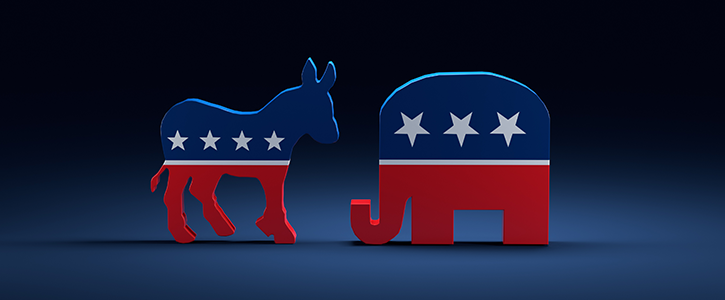Inflation and the economy, taxes and government spending, and abortion are the dominant issues that Connecticut voters are considering as they prepare to elect a governor, according to a poll sponsored by CT Insider and Channel 3 Eyewitness News in Hartford and conducted by the Western New England University Polling Institute.
The poll of 626 likely voters, conducted Sept. 15-21, asked voters to identify the most important issue to them in choosing a candidate in the Nov. 8 election. Democratic Governor Ned Lamont is running for a second four-year term against Republican business executive Bob Stefanowski. The poll, which has a margin of error of plus or minus five percentage points, found Lamont leading Stefanowski in the governor's race by a margin of 55 to 40 percent among likely voters.
The top two issues were "inflation / cost of living / the economy," stated by 24 percent of likely voters, and "taxes / government spending," selected by 22 percent of likely voters. The third most frequently cited issue was "abortion / choice," which was stated by 12 percent of likely voters.
The fourth most common factor was "morals / ethics / personal integrity of the candidate" (eight percent), followed by public education (six percent). The balance of the responses were spread across 12 additional issues and one other candidate trait – party affiliation – with percentages ranging from one to three percent.
"The issues that are relevant to Connecticut voters in the governor's race cover a wide range of concerns," said Tim Vercellotti, director of the Polling Institute and a professor of political science at Western New England University. "The candidates have opportunities to appeal to voters by connecting across many different dimensions."
The order of the top two issues varied by whether respondents completed the survey over the telephone or online. Telephone respondents were most likely to point to taxes and government spending (25 percent), while online respondents were most likely to cite inflation, the cost of living, and the economy (28 percent). Telephone respondents volunteered answers to live interviewers, and the interviewers coded responses using a list of categories. Due to a software programming error, web respondents selected from the list of issue categories instead of typing their responses verbatim on the screen for subsequent coding by Polling Institute staff.
But differences in the response patterns also might have been related to group differences. On average the respondents to the telephone survey tended to be older than those who responded online (average age of 55 for telephone respondents and 49 for online respondents). Women were slightly more likely than men to respond by telephone (53 percent to 46 percent for men), while men were more likely to respond online (48 percent to 45 percent for women, with the balance identifying as other or refusing to respond). The online sample also tended to be slightly better educated than those who responded by phone. Forty-eight percent of online respondents had a college degree compared to 45 percent of telephone respondents. The percentage having a high school diploma or less was higher among telephone respondents, at 31 percent, compared to 20 percent for the online sample.
The survey also asked voters to assess the recent trajectory of the state's economy, their household finances, and crime in their cities and towns.
Voters had negative views of the recent direction of the economy in Connecticut. Looking back over the past 12 months, 52 percent of likely voters said Connecticut's economy has gotten worse, with 28 percent saying it has remained about the same and 17 percent saying it is better.
Views on the health of the state's economy varied by party registration and education. Among Republican likely voters, 75 percent said the state's economy has gotten worse over the past 12 months, and 53 percent of unaffiliated likely voters said the same. Democratic likely voters had a rosier view, and were split almost evenly across the three categories. Thirty percent of Democratic likely voters said the state's economy has gotten better over the past 12 months, while 34 percent said it has gotten worse, and 29 percent said it has remained about the same.
"Democrats and Republicans see two very different Connecticuts when it comes to the state's economy," Vercellotti said.
Views about the economy were more pessimistic at the lower end of the education scale. Among those with a high school diploma or less, 66 percent said the state's economy has gotten worse over the past 12 months, compared to 39 percent of likely voters who reported having a four-year college degree.
Likely voters were more evenly divided over whether their household's financial position has gotten worse or stayed about the same over the past 12 months. Forty-three percent of likely voters said their finances have gotten worse, while 41 percent said their finances have stayed about the same. Only 15 percent said their finances have gotten better.
Views on personal finances also varied significantly by party registration and education. More than half of Democratic likely voters – 55 percent – said their household's financial position has stayed about the same over the past 12 months, while 64 percent of Republican voters said their household finances have gotten worse. Nearly half of unaffiliated likely voters – 49 percent – also said their finances have gotten worse. When broken out by education, likely voters who have a high school diploma or less were the most likely to offer a negative assessment, with 55 percent indicating their household financial position has gotten worse over the past 12 months.
Opinions on crime trends also varied across voter characteristics. Overall, likely voters were almost evenly divided over whether crime has increased or stayed about the same in their city or town over the past four years, since the last time Connecticut elected a governor. Forty-three percent said increased, while 45 percent said that crime has stayed about the same. Only seven percent said crime has decreased in their city or town over a four-year period.
Broken down by party registration, Republican and Democratic likely voters reported widely different views on this issue, with 64 percent of Republican likely voters saying crime has gone up locally over the past four years, compared to 26 percent of Democrats. Nearly half of unaffiliated likely voters – 48 percent – also said crime has gone up in their city or town.
Men were more likely than women – by a margin of 46 percent to 41 percent – to say crime has increased. Differences also emerged by education level, with 48 percent of likely voters with a high school diploma or less saying crime has increased, compared to 37 percent of college graduates.
How do opinions on these issues relate to voter preferences in the governor's race? The survey found that the direction of views about the economy and crime tracked candidate preferences, with positive or neutral views more closely associated with support for the incumbent, Lamont, and negative views more closely associated with support for the challenger, Stefanowski.
Among likely voters who said the state's economy has gotten worse over the past 12 months, 66 percent said they would vote for Stefanowski, and 27 percent said they would vote for Lamont. Among likely voters who thought the state's economy has gotten better, 91 percent said they would vote for Lamont and eight percent said they would vote for Stefanowski. Lamont has support from 80 percent of voters who say the state's economy is "about the same," while 15 percent of those voters favor Stefanowski.
Views on crime aligned with voter preferences in a similar way. Among those who thought crime has gone up in their city or town over the past four years, Stefanowski leads Lamont by a margin of 63 percent to 31 percent. Among likely voters who thought crime has stayed about the same, Lamont leads Stefanowski by a margin of 77 percent to 19 percent.
With regard to the most important issue in choosing a candidate for governor, Stefanowski leads Lamont by significant margins among those who indicated inflation, the cost of living, or the economy was the top issue, and among those who pointed to taxes and government spending. Lamont leads Stefanowski by a large margin among voters who view abortion as the most important issue, and among voters who cited almost all of the other issues.
"The data suggest that if Bob Stefanowski is to close the gap with Ned Lamont, he should focus on the state's economy, government spending, taxes, and crime," Vercellotti said. "Lamont is best served by trying to push back on those issues, or by steering the conversation to other policy issues, such as access to abortion."
The Western New England University Polling Institute, established in 2005, conducts nonpartisan research on public policy issues at the local, state, and regional levels. The Institute, equipped with 23 state-of-the-art computer-assisted telephone interviewing stations, provides the University's faculty and students with valuable opportunities to design and carry out public opinion research. The Institute also conducts survey research for government agencies, news media, and nonprofit organizations.





